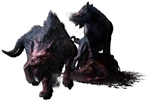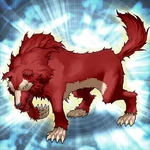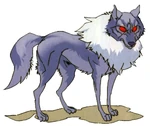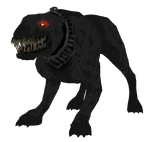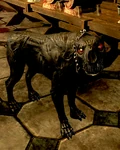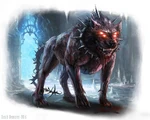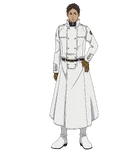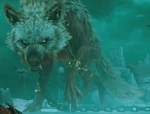Garmr (Old Norse of "rag", whose meaning/etymology is unknown) is a dog or wolf associated with the underworld and the forces of destruction. Little is known about him, since the references to him are sparse and vague. There’s just barely enough material in the surviving Old Norse sources to get a general idea about the kind of being he was perceived to be during the Viking Age.
Myths & Legends[]
In the Grímnismál, one of the poems in the Poetic Edda, Garmr is said to be to canines what Óðinn is to gods and what Yggdrasil is to trees – that is, the greatest among them, the exemplar.[1]
Hound of the Underworld[]
Some scholars have also linked Garmr with the nameless hound of Hel mentioned in another Eddic poem, Baldrs Draumar. The reference to the dog in the poem is only in passing; he barks at Odin as the god rides into the underworld.[2] The identification of Garmr with this hound is difficult to demonstrate conclusively due to the fact that we have no idea what or where "Gnipa Cave" is. Still, cave imagery is used to depict the underworld in mythologies from all over the world, which makes the suggestion that Gnipa Cave is an entrance to the underworld, and Garmr its guardian, far from unreasonable.
Regardless of whether or not Garmr, Fenrir, and the hound of Hel are the same figure, they certainly seem to be little more than multiplications of the same type of figure: a canine associated with the underworld and the forces of chaos who breaks free at the world’s end as an omen of its destruction and in order to aid its destruction. The exact differences between these figures are highly ambiguous, and, in any case, superficial.
Participation in Ragnarök[]
- Main article: Ragnarök
In the Völuspá, another Eddic poem, Garmr is mentioned as part of a refrain that repeats throughout the poem:
Now Garm howls wildlyBefore Gnipa Cave.
Chains will snap
And the wolf will run.[3]
While the reference to Garmr in the Grímnismál calls him a hundr, “dog,” this reference in the Völuspá uses the word freki, "wolf." This refrain is recited as part of an account of the events leading up to and during Ragnarök, the destruction of the cosmos and its re-submergence into chaos. Another one of the events that heralded Ragnarök was the escape of the wolf Fenrir, who had been tied up by the gods and left in a remote swamp so that he wouldn’t devour the cosmos. The two images of bound wolves breaking loose at the same time can't help but make one wonder whether or not Fenrir and Garmr are ultimately the same figure.
This interpretation is supported by the fact that, as the gods and the forces of chaos battled during Ragnarök, the god Týr is said to have engaged Garmr in single combat.[4] Since Týr had earlier tricked Fenrir into allowing himself to be bound in an unbreakable chain, and since Fenrir had bitten off the god's hand in the process, it would make sense for the two to have had a vendetta against each other, which in turn makes it likely that the wolf Týr fought during Ragnarök was none other than Fenrir.[5]
Gallery[]
References[]
- ↑ The Poetic Edda. Grímnismál, stanza 44.
- ↑ The Poetic Edda. Baldrs Draumar, stanza 2.
- ↑ The Poetic Edda. Völuspá. My translation. The original Old Norse reads: Geyr nú Garmr mjök fyr Gnipahelli, festr mun slitna, en freki renna.
- ↑ Snorri Sturluson. The Prose Edda. Gylfaginning.
- ↑ Turville-Petre, E.O.G. 1964. Myth and Religion of the North: The Religion of Ancient Scandinavia. p. 280-281.



